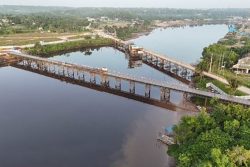Improved water systems were on November 20th commissioned in Potarinau and Katoonarib in Region Nine.
According to a GWI press release, upgrades of the existing water system in Potarinau included the drilling of a new well to a depth of 300 ft and installation of 525 lengths of 50 mm pipelines from the well to the existing water infrastructure.
The system also entailed the installation of a photovoltaic system, the re-plumbing of four 450 gallons water tanks and other additional works.
The water system was set within the central part of Potarinau and was connected to approximately 60 houses along with the school, the health facility and the teacher’s quarters.
Minister within the Ministry of Housing and Water, Susan Rodrigues told the residents that the advancement of potable water supply systems will continue throughout the hinterland.
According to the release, Rodrigues said that the work completed was from available resources from the 2021 budget which saw an investment of $8.5M and allowed around 700 residents to access potable water.
Executive Director of Hinterland Services, Ramchand Jailal stated that the residents will no longer have to fetch water.
At Katoonarib, GWI said close to 400 persons are now receiving access to potable water – 90 percent of the community – as opposed to an initial 25 percent.
GWI said that the newly-commissioned system saw the drilling of a new well by the utility’s Hinterland Team at a depth of close to 300 ft, extension of the existing distribution network, rehabilitation of the water trestle, upgrading of the photovoltaic system and the installation of stand pipes. The project was done in collaboration with the Katoonarib Village Council at a cost of $7.5M and was financed by the Government of Guyana.
Previously, Katoonarib accessed water from a shallow hand-dug well with a depth of approximately 20ft and the water was pumped and stored in a reinforced concrete trestle.
GWI said that during the dry season, the community suffered a water shortage, as the main source would run dry. Additionally, the distribution network did not extend beyond the central point of the community










